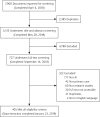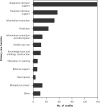Artificial Intelligence and Primary Care Research: A Scoping Review
- PMID: 32393561
- PMCID: PMC7213996
- DOI: 10.1370/afm.2518
Artificial Intelligence and Primary Care Research: A Scoping Review
Abstract
Purpose: Rapid increases in technology and data motivate the application of artificial intelligence (AI) to primary care, but no comprehensive review exists to guide these efforts. Our objective was to assess the nature and extent of the body of research on AI for primary care.
Methods: We performed a scoping review, searching 11 published or gray literature databases with terms pertaining to AI (eg, machine learning, bayes* network) and primary care (eg, general pract*, nurse). We performed title and abstract and then full-text screening using Covidence. Studies had to involve research, include both AI and primary care, and be published in Eng-lish. We extracted data and summarized studies by 7 attributes: purpose(s); author appointment(s); primary care function(s); intended end user(s); health condition(s); geographic location of data source; and AI subfield(s).
Results: Of 5,515 unique documents, 405 met eligibility criteria. The body of research focused on developing or modifying AI methods (66.7%) to support physician diagnostic or treatment recommendations (36.5% and 13.8%), for chronic conditions, using data from higher-income countries. Few studies (14.1%) had even a single author with a primary care appointment. The predominant AI subfields were supervised machine learning (40.0%) and expert systems (22.2%).
Conclusions: Research on AI for primary care is at an early stage of maturity. For the field to progress, more interdisciplinary research teams with end-user engagement and evaluation studies are needed.
Keywords: artificial intelligence; big data; data mining; decision support; diagnosis; electronic health records; family medicine; health informatics; health information technology; primary care; scoping review; treatment.
© 2020 Annals of Family Medicine, Inc.
Figures




References
-
- Beam AL, Kohane IS. Big data and machine learning in health care. JAMA. 2018; 319(13): 1317. - PubMed
-
- Gray R. The A-Z of how artificial intelligence is changing the world. http://www.bbc.com/future/gallery/20181115-a-guide-to-how-artificial-int.... Published Nov 2018 Accessed Mar 18, 2019.
-
- Davenport TH, Ronanki R. Artificial Intelligence for the Real World. Harvard Business Review; 2018. https://hbr.org/2018/01/artificial-intelligence-for-the-real-world Accessed Mar 18, 2019.
-
- Rajkomar A, Dean J, Kohane I. Machine learning in medicine. N Engl J Med. 2019; 380(14): 1347-1358. - PubMed
Publication types
MeSH terms
LinkOut - more resources
Full Text Sources
Miscellaneous
